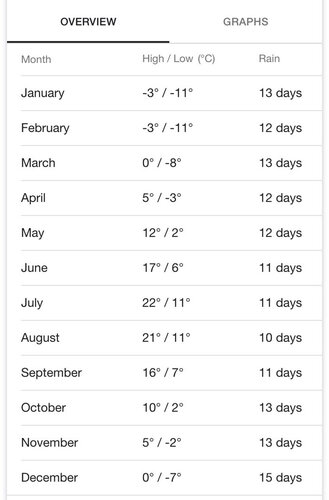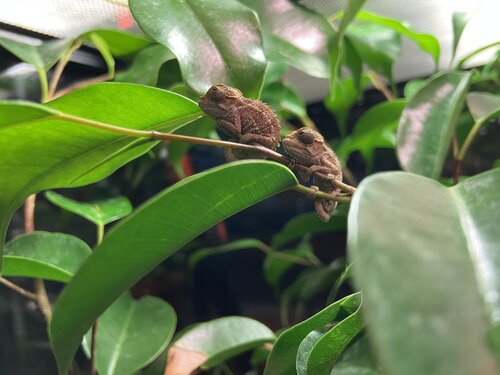Navigation
Install the app
How to install the app on iOS
Follow along with the video below to see how to install our site as a web app on your home screen.
Note: This feature may not be available in some browsers.
More options
You are using an out of date browser. It may not display this or other websites correctly.
You should upgrade or use an alternative browser.
You should upgrade or use an alternative browser.
Helmeted Chameleon surprise
- Thread starter Ben82
- Start date
bobcochran
Chameleon Enthusiast
I wouldn't use a ceramic heater, it will lower the humidity. Moving them twice a day isn't a problem. I move mine depending on the weather; in the morning I move them for sunlight, when it warms up I put them under trees for dappled sunlight. Late in the day back in full sun before dark. They really don't stress that easily.@bobcochran Thank you for replying Bob, I have been searching the forums for info and have read many post where you have given great advice. I’m with you, I find them incredible, they are so friendly and inquisitive and I really hope I can make this work for them.
I guess farmed and WC aren’t any different really, same acclimation and health risks, all I know is the came to Canada via Egypt.
do you think moving them up and down stairs every day is placing undue stress? It’s done in low light conditions while they are still asleep or falling asleep. It’s really the best way I have right now for the temp changes. I could however set up a ceramic heat emitter on a thermostat if you think this would be more beneficial.
Do you have any links to reading materials? I’ve been reading up on Jackson’s babies, as there is more info on them and I’d read a post where @JacksJill had said they have similar requirements. Did you ever put a care sheet together? I thought I’d read you were working on one.
Thank you once again.
From your pictures you have Nairobi area morphs. You can check weather patterns there on the internet. This will give you a better understanding of their requirements. Nairobi is one of the lower elevations (6,000+ft. asl) hoehnelii inhabit. There are populations above 12,000 ft. asl!! Fog occurs frequently at night in Kenya and in theory is a major source of hydration for these and other animals. You might look into getting a fogger.
There just isn't much information on husbandry published for this species. Fortunately they're hardy little guys.
Ben82
Member
Thank you @bobcochran fortunately I had picked up 2 zoo med foggers at the weekend, so I’ve been hand misting them after lights out and again before lights on, until I decide how I want to set them all up properlyI wouldn't use a ceramic heater, it will lower the humidity. Moving them twice a day isn't a problem. I move mine depending on the weather; in the morning I move them for sunlight, when it warms up I put them under trees for dappled sunlight. Late in the day back in full sun before dark. They really don't stress that easily.
From your pictures you have Nairobi area morphs. You can check weather patterns there on the internet. This will give you a better understanding of their requirements. Nairobi is one of the lower elevations (6,000+ft. asl) hoehnelii inhabit. There are populations above 12,000 ft. asl!! Fog occurs frequently at night in Kenya and in theory is a major source of hydration for these and other animals. You might look into getting a fogger.
There just isn't much information on husbandry published for this species. Fortunately they're hardy little guys.
It’s interesting you place them from the Nairobi area, as that’s actually what we had named our female. I had been checking temps for Eldoret, but have since switched over to Nairobi. May I ask where you are located? You have some incredible knowledge of these guys, are they a local species to you or is it just years of accumulated experience?
Thanks once again!
bobcochran
Chameleon Enthusiast
I live on the central coast of Ca., but I wish they were local to me. I've been keeping/breeding hoehnelii for a little over 6 years. I've done a lot of research and suffered through some trial and error to be comfortable enough to share what works for me. There are others who successfully keep entirely indoors. Meaning my way is not the only way, you need to find what works for you.Thank you @bobcochran fortunately I had picked up 2 zoo med foggers at the weekend, so I’ve been hand misting them after lights out and again before lights on, until I decide how I want to set them all up properly
It’s interesting you place them from the Nairobi area, as that’s actually what we had named our female. I had been checking temps for Eldoret, but have since switched over to Nairobi. May I ask where you are located? You have some incredible knowledge of these guys, are they a local species to you or is it just years of accumulated experience?
Thanks once again!
Look up uv indexes for different altitudes around the equator and then the altitude for Nairobi. You'll better understand their uv requirements.
Last edited:
Ben82
Member
Thank you @bobcochran , this is totally going to make me up my UV game. I think I’m going to stick with Arcadia, but I’ll be doing a lot of research and you’ve given me some great things to consider. Im thinking there are probably 2-3 months of the year I’ll be able to keep them outside where I am located
I hope you don’t mind if I message you from time to time. I’ll try not to bug you too much though! If I am successful over the next 6-12 months maybe I’ll put together a care sheet with your approval
Ben
I hope you don’t mind if I message you from time to time. I’ll try not to bug you too much though! If I am successful over the next 6-12 months maybe I’ll put together a care sheet with your approval
Ben
Kaizen
Chameleon Enthusiast
Just a brief note: keeping outdoors really makes things easier. I’m in Canada too, so I know the challenges. What city are you in? Do you have a rough idea of the weather May-September?Thank you @bobcochran , this is totally going to make me up my UV game. I think I’m going to stick with Arcadia, but I’ll be doing a lot of research and you’ve given me some great things to consider. Im thinking there are probably 2-3 months of the year I’ll be able to keep them outside where I am located
I hope you don’t mind if I message you from time to time. I’ll try not to bug you too much though! If I am successful over the next 6-12 months maybe I’ll put together a care sheet with your approval
Ben
Kaizen
Chameleon Enthusiast
For instance, I’m in southern Ontario. I had my chams out May to September this year. Even my pardalis saw temps of 3 degrees c. As long as they had the opportunity to bask, there was no problem. We had 2 month old xantholophus outside in those same temps, and we lost zero, out of 17. Especially with montanes, my experience is that cold is less of an issue than heat. And the latter can be kept in check with smart cage placement and coverage. That’s just my experience. Even if you can house outside from may 15 - sept 15, that will be boon to your clutch.
bobcochran
Chameleon Enthusiast
Kudos Kaizen! I think any outdoor keeping, if done properly is better than anything we can try to reproduce indoors. 1hour of real sunlight is better than 8 hours of any uv bulb. But you have to pay attention, outdoor conditions can change rapidly.For instance, I’m in southern Ontario. I had my chams out May to September this year. Even my pardalis saw temps of 3 degrees c. As long as they had the opportunity to bask, there was no problem. We had 2 month old xantholophus outside in those same temps, and we lost zero, out of 17. Especially with montanes, my experience is that cold is less of an issue than heat. And the latter can be kept in check with smart cage placement and coverage. That’s just my experience. Even if you can house outside from may 15 - sept 15, that will be boon to your clutch.
bobcochran
Chameleon Enthusiast
Ask me whatever you like, if I can help I will.Thank you @bobcochran , this is totally going to make me up my UV game. I think I’m going to stick with Arcadia, but I’ll be doing a lot of research and you’ve given me some great things to consider. Im thinking there are probably 2-3 months of the year I’ll be able to keep them outside where I am located
I hope you don’t mind if I message you from time to time. I’ll try not to bug you too much though! If I am successful over the next 6-12 months maybe I’ll put together a care sheet with your approval
Ben
Kaizen
Chameleon Enthusiast
Agreed!Kudos Kaizen! I think any outdoor keeping, if done properly is better than anything we can try to reproduce indoors. 1hour of real sunlight is better than 8 hours of any uv bulb. But you have to pay attention, outdoor conditions can change rapidly.
Ben82
Member
Thank you the awesome advice @Kaizen and @bobcochran and apologies for the late response. I finally had time to listen to bobs podcasts, a ton of great information in there as well as some delightfully controversial topics which I may weigh in on in a different post. I do however share the philosophy of giving the most natural life possible to any reptile.
I do plan on keeping them outside but maybe @Kaizen you could advise me on that, I’ll post the average annual temps Below. My main question for you right now, is in your dollar store set up you showed me, what strength uvb were you using? Based on the Hoehnelii high uv index do you think a reptisun 10.0 is too much? I have an Arcadia 6% I could use.
Other wise so far so good, I got 4 cups of fruit flies and 4 cups of pin heads to tide me over. I’m going to split them up in 3 groups of 3 so I can monitor their eating better. They are also getting 3 hand fogs at night and early morning and I’m having nice results with the adults urates, I just need to figure out how I want to set the foggers up Permanently
I do plan on keeping them outside but maybe @Kaizen you could advise me on that, I’ll post the average annual temps Below. My main question for you right now, is in your dollar store set up you showed me, what strength uvb were you using? Based on the Hoehnelii high uv index do you think a reptisun 10.0 is too much? I have an Arcadia 6% I could use.
Other wise so far so good, I got 4 cups of fruit flies and 4 cups of pin heads to tide me over. I’m going to split them up in 3 groups of 3 so I can monitor their eating better. They are also getting 3 hand fogs at night and early morning and I’m having nice results with the adults urates, I just need to figure out how I want to set the foggers up Permanently
Attachments
Pearl Fields
Avid Member
OMG THOSE ARE SO CUTE!!!!
Kaizen
Chameleon Enthusiast
I’ll be honest with you here, I used 12% on all the neonate cages. Because I had so much coverage, I was getting uvi’s of 6-7 at the top branch, and .5 near the bottom. My philosophy of uvb has always been use lots, and provide dappled shade all the way up. Yes, it’s true that if the chameleon insists on hanging on the top screen upside down all day, he’ll get a nasty sunburn, but high uvb with high foliage coverage is how it happens in nature. Move one inch to the right and your head and neck are getting uvi 10, but your abdomen and tail (?) are getting 1. An inch to left and things are reversed. That’s not to say that you have to use a 10.0 or 12%, and, as it turns out, fibreglass screen ends up filtering out more uvb light than aluminum, so that will play a part here. But, the long and short of it is, if your solar meter gives you readings anywhere between 0 and 8, and changes as you move your move your hand even slightly, then you’re doing good. I’ll attach some pics below.Thank you the awesome advice @Kaizen and @bobcochran and apologies for the late response. I finally had time to listen to bobs podcasts, a ton of great information in there as well as some delightfully controversial topics which I may weigh in on in a different post. I do however share the philosophy of giving the most natural life possible to any reptile.
I do plan on keeping them outside but maybe @Kaizen you could advise me on that, I’ll post the average annual temps Below. My main question for you right now, is in your dollar store set up you showed me, what strength uvb were you using? Based on the Hoehnelii high uv index do you think a reptisun 10.0 is too much? I have an Arcadia 6% I could use.
Other wise so far so good, I got 4 cups of fruit flies and 4 cups of pin heads to tide me over. I’m going to split them up in 3 groups of 3 so I can monitor their eating better. They are also getting 3 hand fogs at night and early morning and I’m having nice results with the adults urates, I just need to figure out how I want to set the foggers up Permanently
Kaizen
Chameleon Enthusiast
Here’s my uvi’s from one tiny 12”x12”x8” cage
Attachments
-
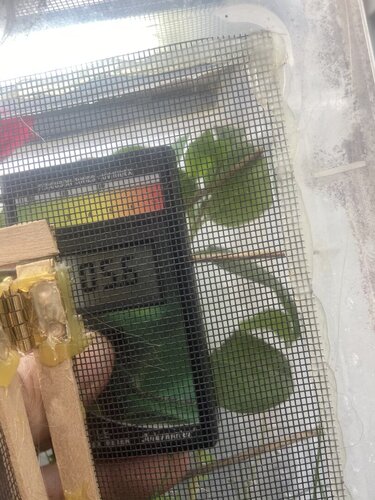 5B6BB442-0879-4F72-BAB2-EBC51373F9AF.jpeg216.8 KB · Views: 183
5B6BB442-0879-4F72-BAB2-EBC51373F9AF.jpeg216.8 KB · Views: 183 -
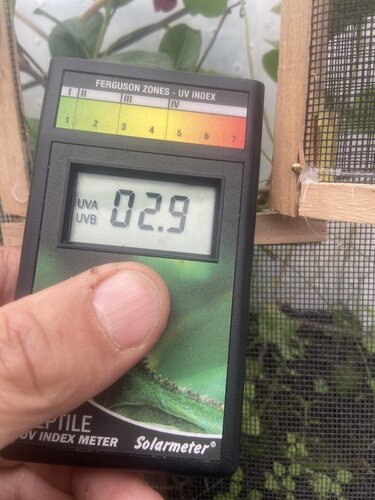 5020E939-913A-4E56-AEBB-5AB12B54FFA4.jpeg159.9 KB · Views: 182
5020E939-913A-4E56-AEBB-5AB12B54FFA4.jpeg159.9 KB · Views: 182 -
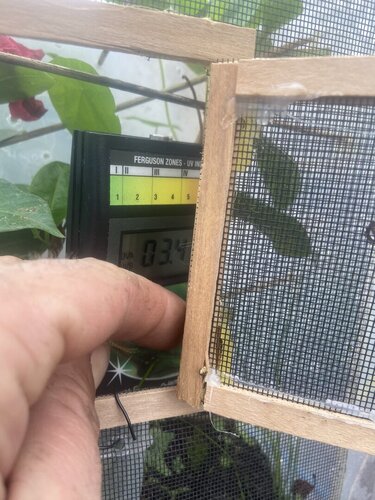 049FF757-F9A6-4FB7-8693-C74B5E825016.jpeg196.4 KB · Views: 179
049FF757-F9A6-4FB7-8693-C74B5E825016.jpeg196.4 KB · Views: 179 -
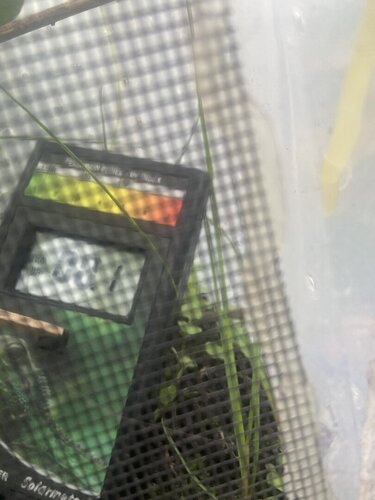 E1EFAD23-D498-4111-B475-934389A63A67.jpeg104.3 KB · Views: 170
E1EFAD23-D498-4111-B475-934389A63A67.jpeg104.3 KB · Views: 170 -
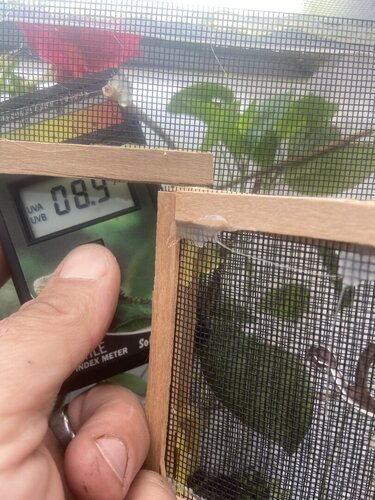 8FB8D8F0-08C6-4130-9C12-0D6BEA64F4D9.jpeg217.6 KB · Views: 169
8FB8D8F0-08C6-4130-9C12-0D6BEA64F4D9.jpeg217.6 KB · Views: 169
Pearl Fields
Avid Member
tested with two solar meters.
Kaizen
Chameleon Enthusiast
You know...if I don’t spend my money, the government will take it.? why do you need 2 though
Ben82
Member
Thank you for the advice, I’m excited to be able to keep them outside.And that’s with a 12%, tested with two solar meters.
with respect to outdoor keeping, you could easily keep outside June through September. So your babes will be getting natural light, air, etc. for a third of the year. That’s pretty darn good!
Similar threads
- Replies
- 7
- Views
- 2K




